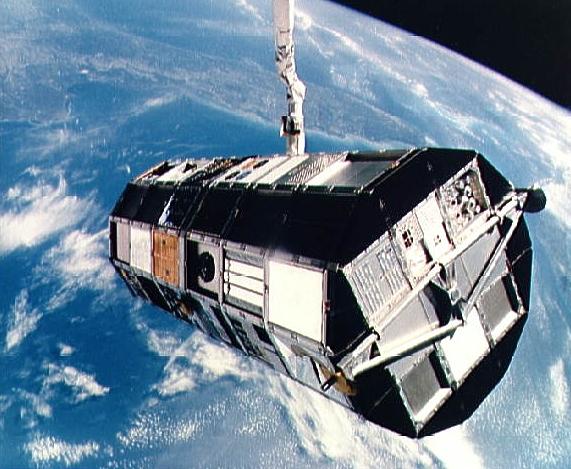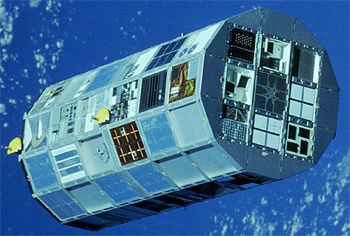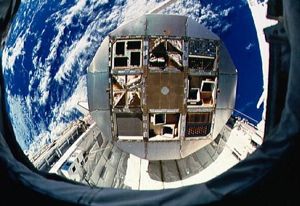
Home - Search - Browse - Alphabetic Index: 0- 1- 2- 3- 4- 5- 6- 7- 8- 9
A- B- C- D- E- F- G- H- I- J- K- L- M- N- O- P- Q- R- S- T- U- V- W- X- Y- Z
LDEF

STS-41-C
Florida Peninsula, LDEF Deploy-RMS
Credit: NASA
AKA: Long Duration Exposure Facility. Status: Operational 1984. First Launch: 1984-04-06. Last Launch: 1984-04-06. Number: 1 . Gross mass: 3,625 kg (7,991 lb). Height: 9.10 m (29.80 ft).
NASA's Long Duration Exposure Facility (LDEF) was designed to provide long-term data on the space environment, including micrometeoroids, and its effects on materials degradation and satellite systems (including power, propulsion, and optics).
The mission's 57 experiments included participation of more than 200 principal investigators from 33 private companies, 21 universities, seven NASA centers, nine Department of Defense laboratories and eight foreign countries. LDEF was released from STS 41-C in April 1984 for a planned one year mission before retrieval by another Shuttle mission. Its planned retrieval was temporarily postponed in March 1985, and then indefinitely postponed by the loss of the Challenger in 1986. It was finally retrieved by STS-32 in January 1990 and returned to Earth. At the time of its retrieval LDEF was about one month away from re-entering the Earth's atmosphere. Many of the experiments were enhanced by the extended stay in space. After landing, the experiments were returned to the investigators' institutions for analysis. The spacecraft was a twelve-sided aluminum, steel, and titanium cylinder, gravity gradient stabilized. A viscous magnetic damper damped out initial oscillations. No telemetry, power, attitude sensors, or propulsion systems were carried. The payload included 57 materials, electronics, and micrometeoroid experiments mounted in 86 trays on the outside of the vehicle.
More at: LDEF.
Family: Earth, Earth micrometeoroid sat. Country: USA. Launch Vehicles: Space Shuttle. Launch Sites: Cape Canaveral, Cape Canaveral LC39A. Agency: NASA, NASA Langley. Bibliography: 2, 279, 6, 6651.
 | LDEF Credit: Manufacturer Image |
 | STS-32 LDEF Retrieval over the Namib Desert, Namibia, Africa Credit: NASA |
 | STS-32 LDEF positioned by RMS over OV-102's payload during STS-32 retrieval Credit: NASA |
 | STS-32 LDEF grappled by remote manipulator system (RMS) during STS-32 retrieval Credit: NASA |
1984 April 6 - . 13:58 GMT - . Launch Site: Cape Canaveral. Launch Complex: Cape Canaveral LC39A. Launch Platform: MLP1. LV Family: Shuttle. Launch Vehicle: Space Shuttle.
- LDEF - . Payload: Challenger F5 / LDEF 1. Mass: 3,625 kg (7,991 lb). Nation: USA. Agency: NASA Langley. Class: Earth. Type: Micrometeoroid satellite. Spacecraft: LDEF. Decay Date: 1990-01-20 . USAF Sat Cat: 14898 . COSPAR: 1984-034B. Apogee: 348 km (216 mi). Perigee: 344 km (213 mi). Inclination: 28.50 deg. Period: 91.50 min. Long Duration Exposure Facility; deployed from STS 41C 7 April 1984; retrieved by STS-32 20 January 1990. Spacecraft engaged in research and exploration of the upper atmosphere or outer space (US Cat B)..
1990 January - .
- LDEF returned to earth - .
Nation: USA.
Spacecraft: LDEF.
NASA's Long Duration Exposure Facility (LDEF) was designed to provide long-term data on the space environment. LDEF was released from STS 41-C in April 1984 for a planned one year mission before retrieval by another Shuttle mission. Its planned retrieval was postponed by the loss of the Challenger in 1986. It was finally retrieved by STS-32 in January 1990 and returned to Earth. At the time of its retrieval LDEF was about one month away from re-entering the Earth's atmosphere. Many of the experiments were enhanced by the extended stay in space.
Back to top of page
Home - Search - Browse - Alphabetic Index: 0- 1- 2- 3- 4- 5- 6- 7- 8- 9
A- B- C- D- E- F- G- H- I- J- K- L- M- N- O- P- Q- R- S- T- U- V- W- X- Y- Z
© 1997-2019 Mark Wade - Contact
© / Conditions for Use